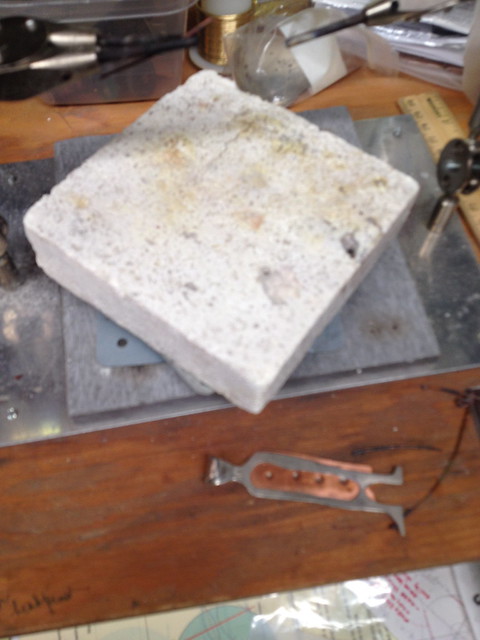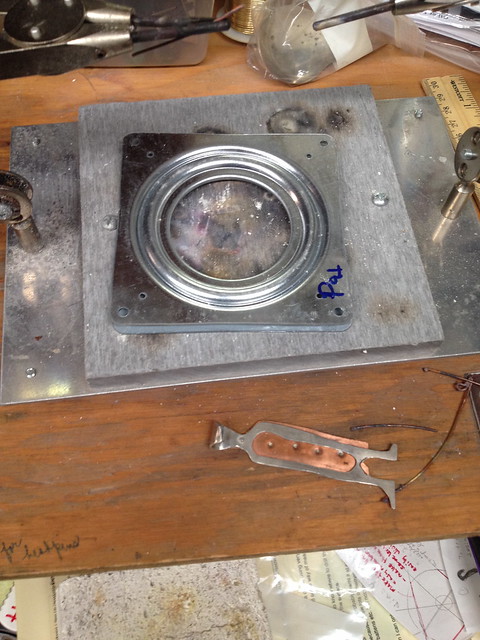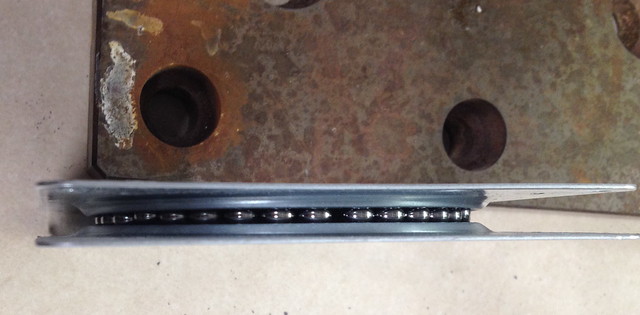|
|
Post by Pat on Sept 22, 2015 22:36:09 GMT -5
Just found out about this. What a help!  IMG_3368 IMG_3368 by Pat, on Flickr 1 This is my 6" white soldering brick sitting on a Lazy Susan turntable. The is sitting on the permanent soldering station. 2  IMG_3367 IMG_3367 by Pat, on Flickr Here is is without the white soldering brick 3  IMG_3368 IMG_3368 by Pat, on Flickr Here it is in position turned. It spins easily to evenly solder the entire piece. 4-  IMG_3372 IMG_3372 by Pat, on Flickr Here it is on its side showing how thin it is --- about ¼" max. It was about $5 from amazon. Lots of sizes. Home Depot had it at 6", but that was too big to make the spin on the soldering station. |
|
Tom
fully equipped rock polisher
   My dad Tom suddenly passed away yesterday, Just wanted his "rock" family to know.
My dad Tom suddenly passed away yesterday, Just wanted his "rock" family to know.
Member since January 2013
Posts: 1,557
|
Post by Tom on Sept 23, 2015 21:32:12 GMT -5
Great idea Pat!
|
|
|
|
Post by toiv0 on Sept 25, 2015 2:35:51 GMT -5
I have used one for a while and also love it.
|
|
Don
Cave Dweller  He wants you too, Malachi.
He wants you too, Malachi.
Member since December 2009
Posts: 2,616
|
Post by Don on Sept 25, 2015 9:30:01 GMT -5
I actually prefer a stationary soldering station. If I need the piece to move around, I'll grab a soldering pick to push it around.
|
|
|
|
Post by Rockoonz on Sept 25, 2015 12:01:42 GMT -5
Love it Pat. I don't know how big your pieces are, if you're going to be getting a lot of heat that might get down to the bearings on the lazy susan you might consider coating them with a high temp anti sieze to prevent them from rusting. I use the soft fire bricks and carve out recesses to stand up bezels and ring shanks when soldering, being able to easily turn a piece to get a better angle for the torch seems like a great advantage to me, or when heating large non-jewelry pieces for annealing as well. What I really need is the perfect reading/safety glasses so I can see for sure when the solder is melted. |
|
|
|
Post by Pat on Sept 25, 2015 15:38:49 GMT -5
Love it Pat. I don't know how big your pieces are, if you're going to be getting a lot of heat that might get down to the bearings on the lazy susan you might consider coating them with a high temp anti sieze to prevent them from rusting. I use the soft fire bricks and carve out recesses to stand up bezels and ring shanks when soldering, being able to easily turn a piece to get a better angle for the torch seems like a great advantage to me, or when heating large non-jewelry pieces for annealing as well. What I really need is the perfect reading/safety glasses so I can see for sure when the solder is melted. My pieces are all jewelry pieces, most not very big. Will look into your rust prevention; sounds like a good idea anyway. My soldering brick is also soft, so I can stick pins in it. I like your idea of carving out areas for standing bezels. I always wear prescription glasses, and the optivisor fits over them easily. Maybe that would help your situation. Thanks! |
|
|
|
Post by jakesrocks on Sept 25, 2015 19:19:42 GMT -5
Love it Pat. I don't know how big your pieces are, if you're going to be getting a lot of heat that might get down to the bearings on the lazy susan you might consider coating them with a high temp anti sieze to prevent them from rusting. I use the soft fire bricks and carve out recesses to stand up bezels and ring shanks when soldering, being able to easily turn a piece to get a better angle for the torch seems like a great advantage to me, or when heating large non-jewelry pieces for annealing as well. What I really need is the perfect reading/safety glasses so I can see for sure when the solder is melted. You can get prescription welding lenses which are clear & made to fit under the dark welding lens. I'm sure they make them for gas welding goggles as well. Just use the clear protective lens over them. In the later years of my welding & sheet metal career, I had to use fairly powerful magnifying lenses. |
|